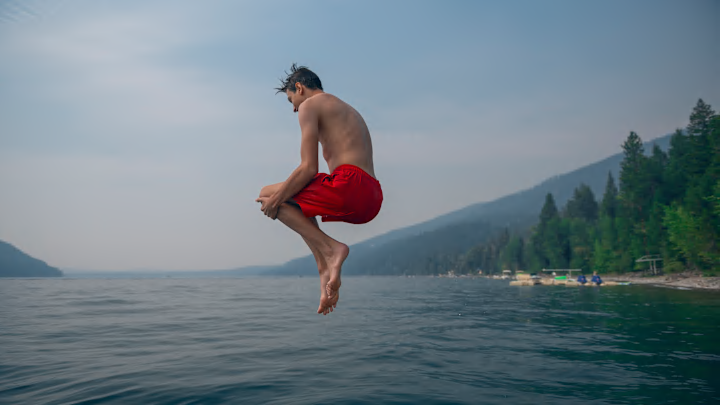For many, a trip to the lake with family or friends is a summer highlight. There’s nothing quite like soaking up the sun and then taking a dip in the lake to cool off. But sometimes the water can look a bit … intimidating.
Maybe the water’s a bit murky, you see some fish swimming around, or you feel something tickling at your ankle. Or maybe you’ve read one too many stories about the brain-eating amoeba. It can make you wonder: Is a quick dip in the lake actually all that safe?
The answer is, well, sometimes. Here’s what to know before you wade in, and how to swim safely when you do.
- Why Is It Risky to Swim in Natural Bodies of Water?
- How Rare Is the Brain Eating Amoeba?
- Warning Signs to Watch For
- How to Swim Safely in Wild Water
Why Is It Risky to Swim in Natural Bodies of Water?
Any natural body of water—whether that be a lake, river, or even an ocean—comes with its risks. This is primarily because they aren’t disinfected like swimming pools. That means they can harbor bacteria, parasites, viruses, and creepy crawlies of all types.

According to the Centers for Disease Control and Prevention (CDC), one of the biggest concerns is fecal contamination. Germs from animal waste and untreated sewage can enter swimming areas through drains or pipes. Unsurprisingly, this can lead to serious illnesses if swallowed or introduced through open cuts.
Lakes specifically tend to hold onto pollutants longer than rivers or oceans because they’re relatively still. There’s no tide to flush the bacteria away, which means any contamination lingers.
How Rare Is the Brain Eating Amoeba?
Naegleria fowleri—a.k.a. the “brain-eating amoeba”—can be found in freshwater bodies of water and soil all over the Earth. The amoeba can cause a fatal infection known as primary amebic meningoencephalitis (PAM) if it enters a person’s brain. It’s a very rare condition—according to the CDC, there were 164 known cases of people in the United States contracting PAM between 1962 to 2023.
Warning Signs to Watch For
Before diving into the lake with your buddies, do a quick safety check:
- Is the water cloudy, discolored, or smelly? That could signal bacterial overgrowth or problematic algae.
- Have there been recent storms? Try to avoid swimming within 24–48 hours of heavy rainfall.
- Are there visible pipes nearby? Pipes emptying into a waterway could be draining pollutants.
- Do you have an open wound, a healing piercing, or tattoo? Germs in the water can enter your body through broken skin.
- Is there an advisory posted? Many swimming areas monitor water quality and will post notices if bacteria levels are unsafe.
If any of the above apply, it’s probably best to stay on land and admire the water from a distance.
How to Swim Safely in Wild Water
If you go through that list and things seem to check out, there are still extra precautions you can take to have the cleanest, safest experience possible.
- Don’t swallow the water—no matter how clear it may look.
- Avoid stirring up sand and sediment, and try to keep your head above water.
- Wear water shoes to protect your feet from getting cut on rocks or other debris.
- Check yourself for any cuts, scrapes, or other wounds before entering the water.
- Once you’re done swimming, plan to rinse yourself off with clean water (a quick shower would work, but so would spraying yourself with a hose).

You should also follow basic water safety advice:
- Never swim alone, and make sure any children are closely supervised.
- Pay attention to any warning or safety signs.
- Avoid entering the water while drunk or under the influence of drugs.
- Never swim during a thunderstorm.
- When in doubt, wear a life vest or simply stick to safely dipping your toes in from the shore.
Read More About Water:
